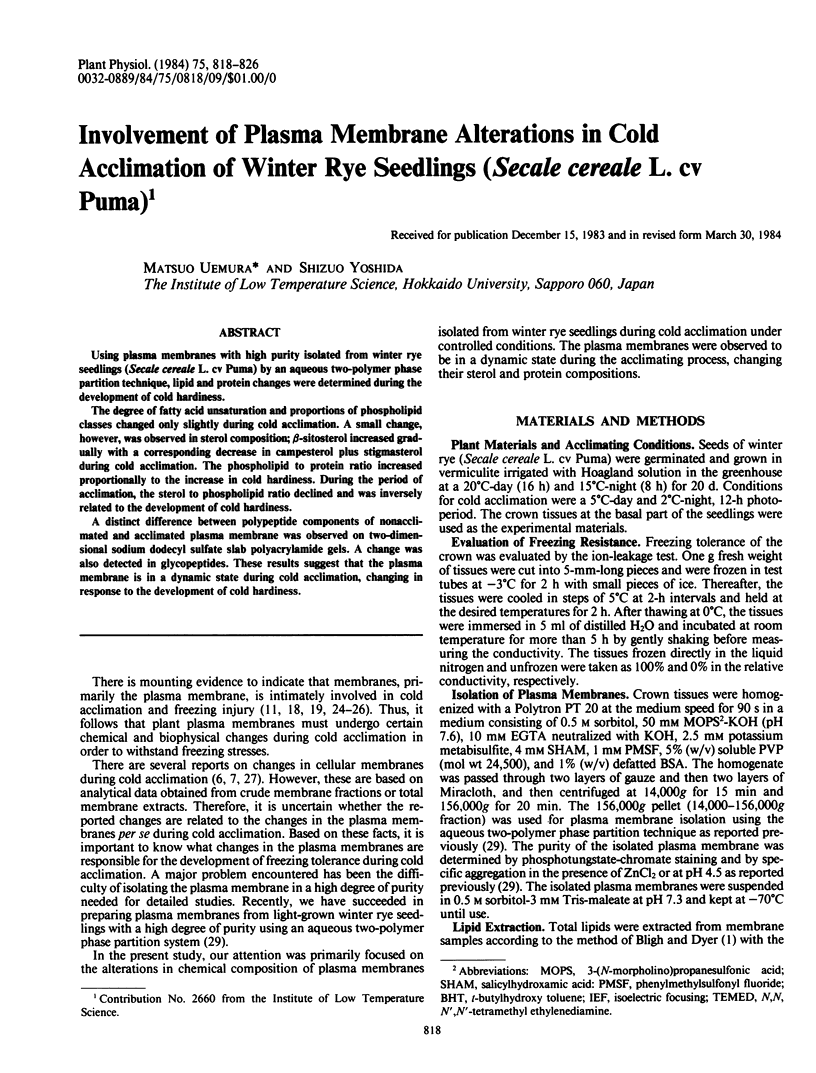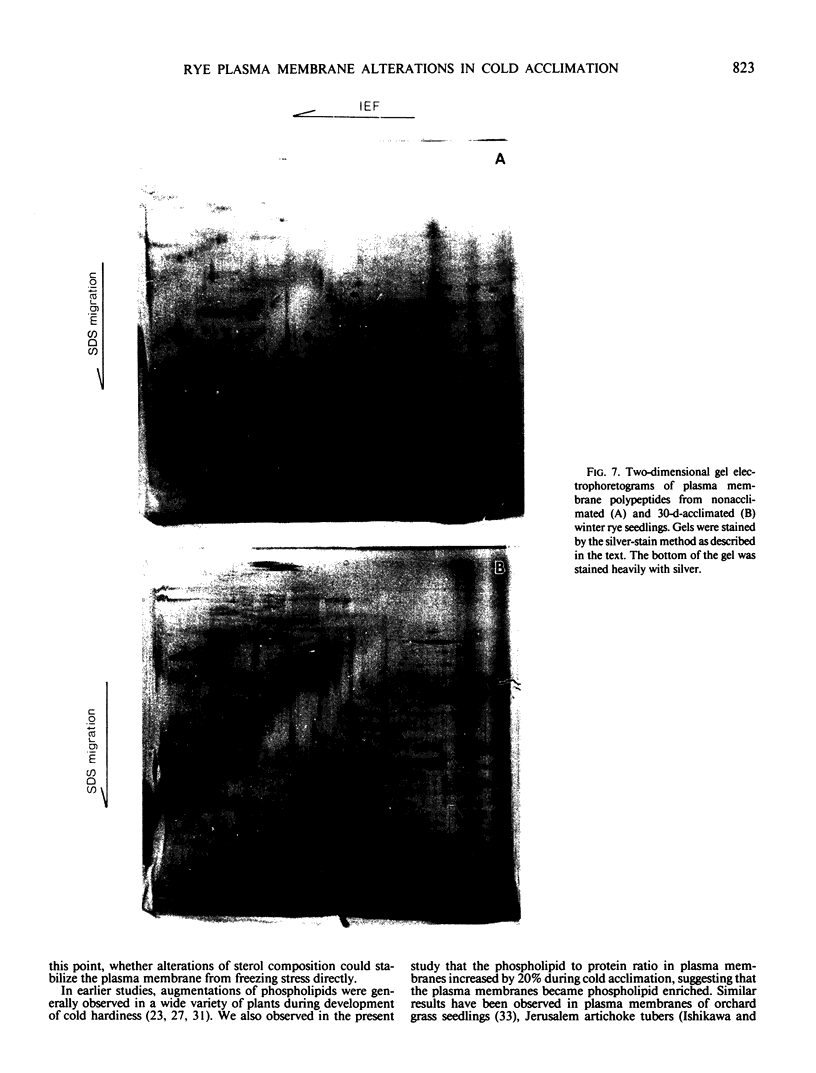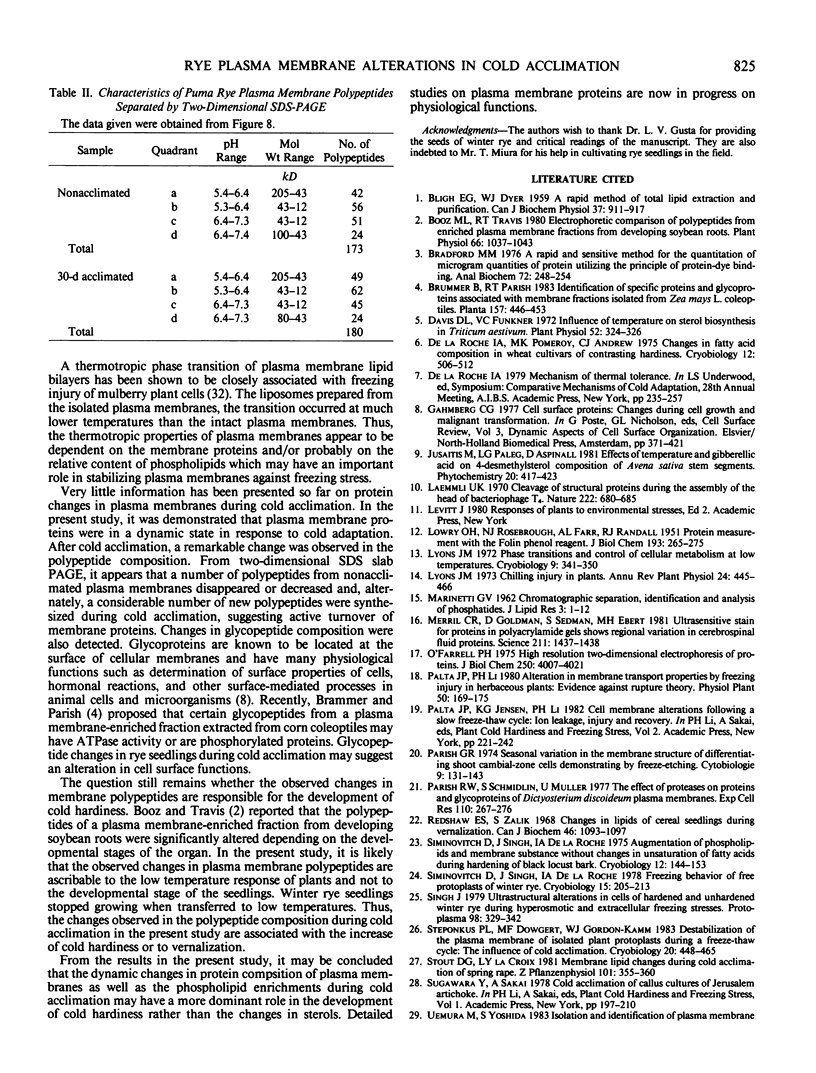Abstract
Using plasma membranes with high purity isolated from winter rye seedlings (Secale cereale L. cv Puma) by an aqueous two-polymer phase partition technique, lipid and protein changes were determined during the development of cold hardiness.
The degree of fatty acid unsaturation and proportions of phospholipid classes changed only slightly during cold acclimation. A small change, however, was observed in sterol composition; β-sitosterol increased gradually with a corresponding decrease in campesterol plus stigmasterol during cold acclimation. The phospholipid to protein ratio increased proportionally to the increase in cold hardiness. During the period of acclimation, the sterol to phospholipid ratio declined and was inversely related to the development of cold hardiness.
A distinct difference between polypeptide components of nonacclimated and acclimated plasma membrane was observed on two-dimensional sodium dodecyl sulfate slab polyacrylamide gels. A change was also detected in glycopeptides. These results suggest that the plasma membrane is in a dynamic state during cold acclimation, changing in response to the development of cold hardiness.
Full text
PDF








Images in this article
Selected References
These references are in PubMed. This may not be the complete list of references from this article.
- BLIGH E. G., DYER W. J. A rapid method of total lipid extraction and purification. Can J Biochem Physiol. 1959 Aug;37(8):911–917. doi: 10.1139/o59-099. [DOI] [PubMed] [Google Scholar]
- Booz M. L., Travis R. L. Electrophoretic comparison of polypeptides from enriched plasma membrane fractions from developing soybean roots. Plant Physiol. 1980 Dec;66(6):1037–1043. doi: 10.1104/pp.66.6.1037. [DOI] [PMC free article] [PubMed] [Google Scholar]
- Bradford M. M. A rapid and sensitive method for the quantitation of microgram quantities of protein utilizing the principle of protein-dye binding. Anal Biochem. 1976 May 7;72:248–254. doi: 10.1006/abio.1976.9999. [DOI] [PubMed] [Google Scholar]
- Davis D. L., Finkner V. C. Influence of Temperature on Sterol Biosynthesis in Triticum aestivum. Plant Physiol. 1973 Oct;52(4):324–326. doi: 10.1104/pp.52.4.324. [DOI] [PMC free article] [PubMed] [Google Scholar]
- LOWRY O. H., ROSEBROUGH N. J., FARR A. L., RANDALL R. J. Protein measurement with the Folin phenol reagent. J Biol Chem. 1951 Nov;193(1):265–275. [PubMed] [Google Scholar]
- Laemmli U. K. Cleavage of structural proteins during the assembly of the head of bacteriophage T4. Nature. 1970 Aug 15;227(5259):680–685. doi: 10.1038/227680a0. [DOI] [PubMed] [Google Scholar]
- Lyons J. M. Phase transitions and control of cellular metabolism at low temperatures. Cryobiology. 1972 Oct;9(5):341–350. doi: 10.1016/0011-2240(72)90152-6. [DOI] [PubMed] [Google Scholar]
- Merril C. R., Goldman D., Sedman S. A., Ebert M. H. Ultrasensitive stain for proteins in polyacrylamide gels shows regional variation in cerebrospinal fluid proteins. Science. 1981 Mar 27;211(4489):1437–1438. doi: 10.1126/science.6162199. [DOI] [PubMed] [Google Scholar]
- O'Farrell P. H. High resolution two-dimensional electrophoresis of proteins. J Biol Chem. 1975 May 25;250(10):4007–4021. [PMC free article] [PubMed] [Google Scholar]
- Parish R. W., Schmidlin S., Müller U. The effects of proteases on proteins and glycoproteins of Dictyostelium discoideum plasma membranes. Exp Cell Res. 1977 Dec;110(2):267–276. doi: 10.1016/0014-4827(77)90292-0. [DOI] [PubMed] [Google Scholar]
- Redshaw E. S., Zalik S. Changes in lipids of cereal seedlings during vernalization. Can J Biochem. 1968 Sep;46(9):1093–1097. doi: 10.1139/o68-163. [DOI] [PubMed] [Google Scholar]
- Siminovitch D., De la Roche I. A. Freezing behavior of free protoplasts of winter rye. Cryobiology. 1978 Apr;15(2):205–213. doi: 10.1016/0011-2240(78)90025-1. [DOI] [PubMed] [Google Scholar]
- Siminovitch D., Singh J., de la Roche I. A. Studies on membranes in plant cells resistant to extreme freezing. I. Augmentation of phospholipids and membrane substance without changes in unsaturation of fatty acids during hardening of black locust bark. Cryobiology. 1975 Apr;12(2):144–153. doi: 10.1016/s0011-2240(75)80006-x. [DOI] [PubMed] [Google Scholar]
- Steponkus P. L., Dowgert M. F., Gordon-Kamm W. J. Destabilization of the plasma membrane of isolated plant protoplasts during a freeze-thaw cycle: the influence of cold acclimation. Cryobiology. 1983 Aug;20(4):448–465. doi: 10.1016/0011-2240(83)90035-4. [DOI] [PubMed] [Google Scholar]
- Uemura M., Yoshida S. Isolation and Identification of Plasma Membrane from Light-Grown Winter Rye Seedlings (Secale cereale L. cv Puma). Plant Physiol. 1983 Nov;73(3):586–597. doi: 10.1104/pp.73.3.586. [DOI] [PMC free article] [PubMed] [Google Scholar]
- Yoshida S., Uemura M. Protein and Lipid Compositions of Isolated Plasma Membranes from Orchard Grass (Dactylis glomerata L.) and Changes during Cold Acclimation. Plant Physiol. 1984 May;75(1):31–37. doi: 10.1104/pp.75.1.31. [DOI] [PMC free article] [PubMed] [Google Scholar]
- Zlatkis A., Zak B. Study of a new cholesterol reagent. Anal Biochem. 1969 Apr 11;29(1):143–148. doi: 10.1016/0003-2697(69)90017-7. [DOI] [PubMed] [Google Scholar]
- de la Roche I. A., Pomeroy M. K., Andrews C. J. Changes in fatty acid composition in wheat cultivars of contrasting hardiness. Cryobiology. 1975 Oct;12(5):506–512. doi: 10.1016/0011-2240(75)90032-2. [DOI] [PubMed] [Google Scholar]





